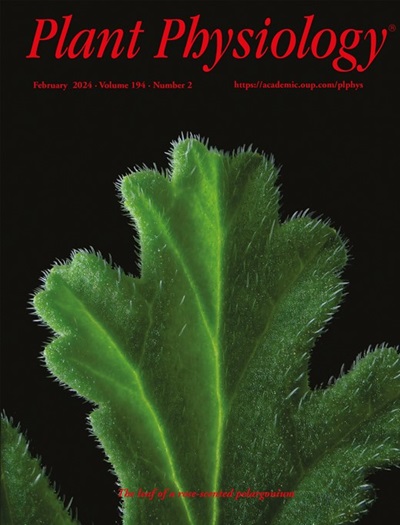The aldehyde (ALD) locus controls C6-aldehyde production in kiwifruit and affects consumer perception of fruit aroma
IF 6.5
1区 生物学
Q1 PLANT SCIENCES
引用次数: 0
Abstract
Volatile C6-aldehydes contribute green/grassy notes to the aroma of many unripe fruits. C6-aldehydes are also likely important contributors to flavor intensity in fruits that remain green when ripe, including green-fleshed kiwifruit (Actinidia spp.). Here, we investigated the genetic basis for aldehyde production in kiwifruit in an A. chinensis mapping population. A major quantitative trait locus for producing multiple aldehydes was identified on chromosome 28 and named the aldehyde (ALD) locus. This locus co-located with three tandemly arrayed A. chinensis LIPOXYGENASE (AcLOX4a–c) genes in the Red5 genome. Expression of the ALD 13-LOX genes and aldehyde production decreased as the fruit developed and ripened in multiple Actinidia spp. In planta transient overexpression and biochemical analysis indicated that AcLOX4a and AcLOX4c produce hexanal and hexenal isomers. The third gene, AcLOX4b, was inactive and likely a pseudogene. The ALD LOX genes were targeted for CRISPR-Cas9 knockout, generating A. chinensis kiwifruit lines that contained insertions/deletions in all three target genes. Gas chromatography-mass spectrometry analysis showed that C6-aldehyde levels were reduced in leaves and fruit of the CRISPR-Cas9 lines, with a > 90% reduction in line CAL5-2 compared to the control. Sensory aroma analysis showed that consumers could readily discriminate unripe CAL5-2 fruit from controls, describing the fruit as less grassy. Consumer discrimination was weaker in ethylene-ripened CAL5-2 fruit, likely due to high levels of fruity esters. Our results validate the importance of C6-aldehydes in kiwifruit flavor, and our characterization of the ALD locus is a critical step toward maintaining and improving flavor intensity in kiwifruit.醛(ALD)基因座控制猕猴桃中c6 -醛的产生,影响消费者对水果香气的感知
挥发性c6 -醛为许多未成熟水果的香气增添了绿色/青草的气息。c6 -醛也可能是水果成熟时保持绿色的味道强度的重要贡献者,包括绿瓤猕猴桃(猕猴桃属)。在此,我们研究了中国猕猴桃定位群体中猕猴桃醛产生的遗传基础。在28号染色体上发现了一个主要的产多醛数量性状位点,命名为醛(ALD)位点。该位点与3个串联排列的A. chinensis LIPOXYGENASE (AcLOX4a-c)基因在Red5基因组中共定位。在多个猕猴桃属植物中,ALD 13-LOX基因的表达和醛产量随着果实的发育和成熟而下降。在植物中,瞬态过表达和生化分析表明,AcLOX4a和AcLOX4c产生己醛和己烯醛异构体。第三个基因AcLOX4b没有活性,很可能是一个假基因。ALD LOX基因被CRISPR-Cas9敲除,产生了包含所有三个靶基因插入/缺失的中国猕猴桃品系。气相色谱-质谱分析显示,CRISPR-Cas9系的叶片和果实中c6 -醛的含量降低,且含量明显降低。与对照组相比,CAL5-2减少了90%。感官香气分析表明,消费者可以很容易地将未成熟的CAL5-2果实与对照区分开来,认为果实的草味较少。消费者对乙烯成熟的CAL5-2水果的辨别能力较弱,可能是由于水果酯含量高。我们的研究结果验证了c6 -醛在猕猴桃风味中的重要性,我们对ALD位点的表征是保持和提高猕猴桃风味强度的关键一步。
本文章由计算机程序翻译,如有差异,请以英文原文为准。
求助全文
约1分钟内获得全文
求助全文
来源期刊

Plant Physiology
生物-植物科学
CiteScore
12.20
自引率
5.40%
发文量
535
审稿时长
2.3 months
期刊介绍:
Plant Physiology® is a distinguished and highly respected journal with a rich history dating back to its establishment in 1926. It stands as a leading international publication in the field of plant biology, covering a comprehensive range of topics from the molecular and structural aspects of plant life to systems biology and ecophysiology. Recognized as the most highly cited journal in plant sciences, Plant Physiology® is a testament to its commitment to excellence and the dissemination of groundbreaking research.
As the official publication of the American Society of Plant Biologists, Plant Physiology® upholds rigorous peer-review standards, ensuring that the scientific community receives the highest quality research. The journal releases 12 issues annually, providing a steady stream of new findings and insights to its readership.
 求助内容:
求助内容: 应助结果提醒方式:
应助结果提醒方式:


